Article by Shireen Tawil
The first few months of 2020 shook up our lives in a way few of us have ever experienced. Beginning in China and moving outwards rapidly, lockdowns swept the world in a domino effect. People were told to stay home, non-essential businesses were closed, the roaring engines of manufacturing and industry fell silent, and the streets of cities that never sleep suddenly echoed with emptiness.

Clear sky and water. Venice, Italy. June, 2020. Photo by Janou Baton.
People across the world experienced tremendous grief as hundreds of thousands lost their lives to COVID-19, and we were forced to accept a ‘new normal’. The deep pain felt by so many of us at the loss of life cannot be overstated, and carries a weight that cannot, and should not, be brushed aside. Without discounting the emotional toll at its source, this abrupt disruption of the world’s daily rhythms has raised many truths - previously hidden beneath the hustle and bustle of busy life - up to the surface.
This disruption has shattered illusions, exposing outrageous inequalities around the world, revealing the brutality our current socio-economic structures inflict upon so many lives. Among these shattered perceptions is the idea that our air pollution is not quite so bad. With factories stopped, cars parked, and airplanes grounded, the skies opened up for us and the waters cleared. The drop in emissions has thus brought the issue of air pollution to the attention of many in a more tangible way.
My terrace in Milan has always confronted me with the dirty air we breathe here. The pollution is so high that if I don’t scrub the terrace clean weekly, my children come inside with their hands and feet covered in black soot. My five-year-old is asthmatic and has been hospitalized twice for pneumonia - the first time coming just a week shy of his first birthday. During the 70+ days of lockdown we experienced, I cleaned my terrace once, around day 10, and it is only now (90 days later) that I need to give it another clean. The difference in the terrace’s sootiness between the two periods is startling, and illustrates the impact the drop in emissions must have had.
What’s Polluting Our Air in the First Place?

Exhaust from generators. Beirut, Lebanon. January, 2020. Photo by author.
The three biggest contributors to air pollution are particulate matter (PM), ozone, and household pollutants. Their high presence in the air we breathe is dangerous to the health of both humans and the planet.
Particulate Matter
PM is a combination of solid particles and liquid droplets in the air. Dust, dirt, soot and smoke are examples of visible forms of PM, while other particles are so small they can only be seen with a microscope. PM pollution is made up of two categories: PM10 (PM with a diameter of 10 micrometers) and PM2.5 (PM with a diameter of 2.5 micrometers). To put their size in perspective, a human hair has a diameter of 70 micrometers, meaning it is seven times larger than a PM10 and nearly 30 times larger than a PM2.5.
Some particulates are directly emitted, for example from construction sites or the paving of roads. Others form in the atmosphere through a reaction between chemicals emitted by power plants, factories, and vehicles.

https://www.epa.gov/pm-pollution/health-and-environmental-effects-particulate-matter-pm, https://www.stateofglobalair.org/data/estimate-burden
Ozone
There are two kinds of ozone - stratospheric ozone (the good kind, found in the atmosphere, which occurs naturally and protects us from the sun’s ultraviolet rays) and ground ozone (the bad kind, a man-made pollutant created by a combination of emissions and sunlight - also known as smog - that increases our risk of respiratory illnesses). A key ingredient in this pollutant is nitrogen dioxide, or NO2.

https://www.epa.gov/ground-level-ozone-pollution/ground-level-ozone-basics
Household Pollutants
These can be any number of pollutants: cigarette smoke, fuel for cooking, cleaning sprays, mosquito repellents, or artificial fragrances. They are common and vary around the world.
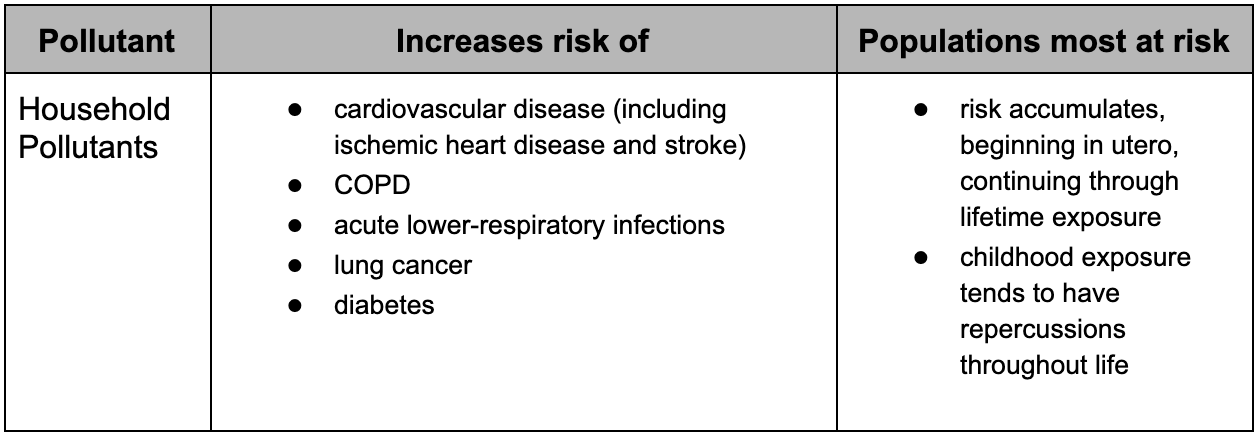
https://www.ncbi.nlm.nih.gov/pmc/articles/PMC5089137/, https://www.stateofglobalair.org/health
What Do Air Pollutants Do to Our Health?
These three air pollutants contaminate the air we breathe, turning this vital, life-sustaining resource into one that may also compromise our health. They each harm our health differently, increasing the risk of certain health problems. We take an average of 25,000 breaths a day, giving us that many chances of breathing PM10, or smaller particles, deep into our lungs. They may even enter our bloodstream.
Short-term exposure to ground ozone can increase asthma complications, and long-term exposure can even increase the risk of death due to Chronic Obstructive Pulmonary Disease (COPD). Household pollutants have also been shown to affect our health in the womb, before we are even born. And early childhood exposures “tend to have repercussions throughout life.”

Spray cleaners are a common household pollutant. Photo by Crystal de Passilleé-Chabot, unsplash.com.
Beyond the slew of respiratory illnesses caused by pollutants in the air, there is also an increased occurrence of death, ‘with total air pollution (PM2.5, ozone, and household pollution) contribut[ing] to almost five million deaths globally - nearly 1 in 10 deaths - in 2017.’ With 90% of the world’s population breathing dangerously polluted air, it is evident that the pollutants we are pumping into the air are threatening our lives. These levels of air pollution disproportionately affect the Global South, low-income communities, and communities of color - illustrating the link between poverty and health, and the need for climate justice.
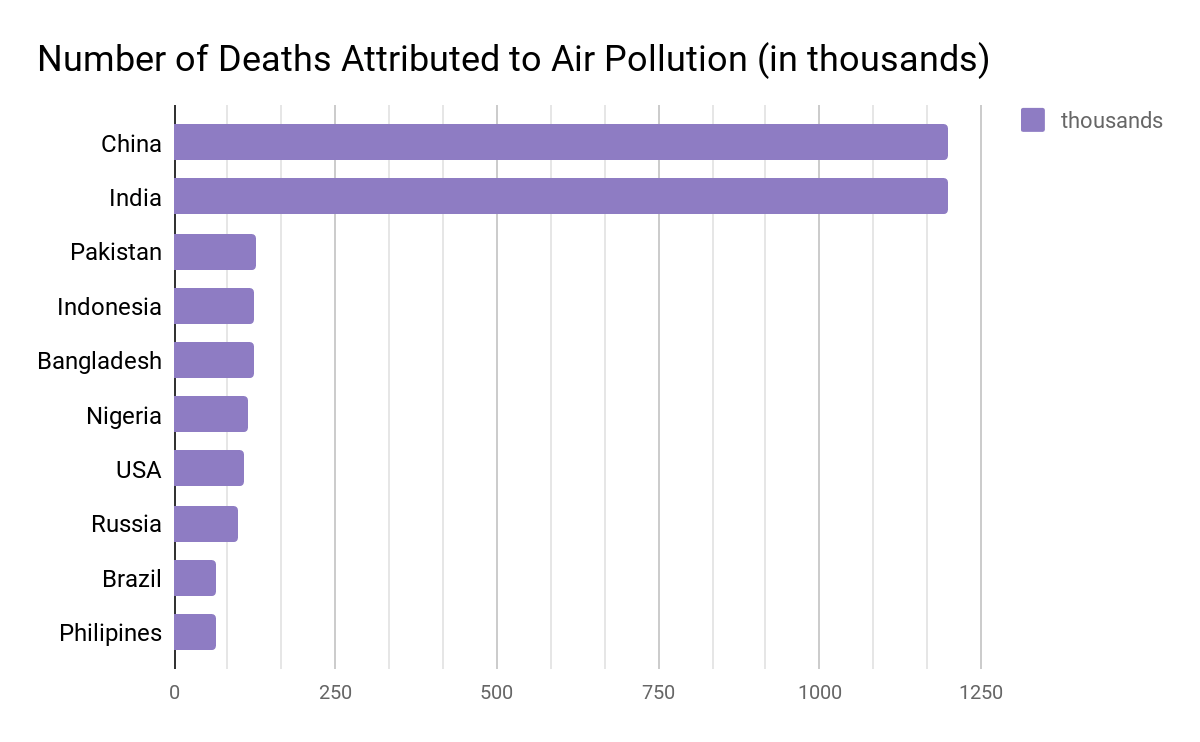
Data Source: https://www.stateofglobalhealth.org/health
The Fall in Air Pollution Has Shown A Positive Health Impact
But during the months that countries went into lockdown, something extraordinary happened: our air became cleaner - by a lot. Factories stopped churning out pollutants and road and air traffic basically came to a standstill. In major cities around the world, air pollution plummeted as lockdowns went on. In some cases, it fell far below the last four years’ national average for that same period of time.
In Delhi, PM2.5 rates decreased by 60%, and Los Angeles had its longest period of ‘clean air’ as defined by WHO guidelines. Satellite images have captured the visible difference in air pollution over the first quarter of 2020 in various cities across the world, and the change is striking. In Europe, PM10 dropped dramatically, by an average of 10%, during the 30-day period from March 27 to April 25, and NO2 decreased by approximately 40% from its average levels.
We have seen huge shifts in energy use too, which have contributed to the fall in pollutants. During the first quarter of 2020, non-renewable energy fell dramatically, as demand decreased, and the use of renewable energy increased. Around the world, countries shifted away from fossil fuels: Austria and Sweden closed their last coal power plants; Portugal was coal-free for at least 2 months; the UK did it for at least 35 days; and the Netherlands reduced its coal plants by 75% to comply with a court order to reduce the risks associated with the climate emergency. In a huge boost for renewable energy, India, the world's second-biggest coal consumer, is ditching coal and prioritizing low-cost solar energy for its electricity needs. The change in energy use was so significant that the oil and gas industry crashed, with experts saying it is unlikely to return to its former standing.
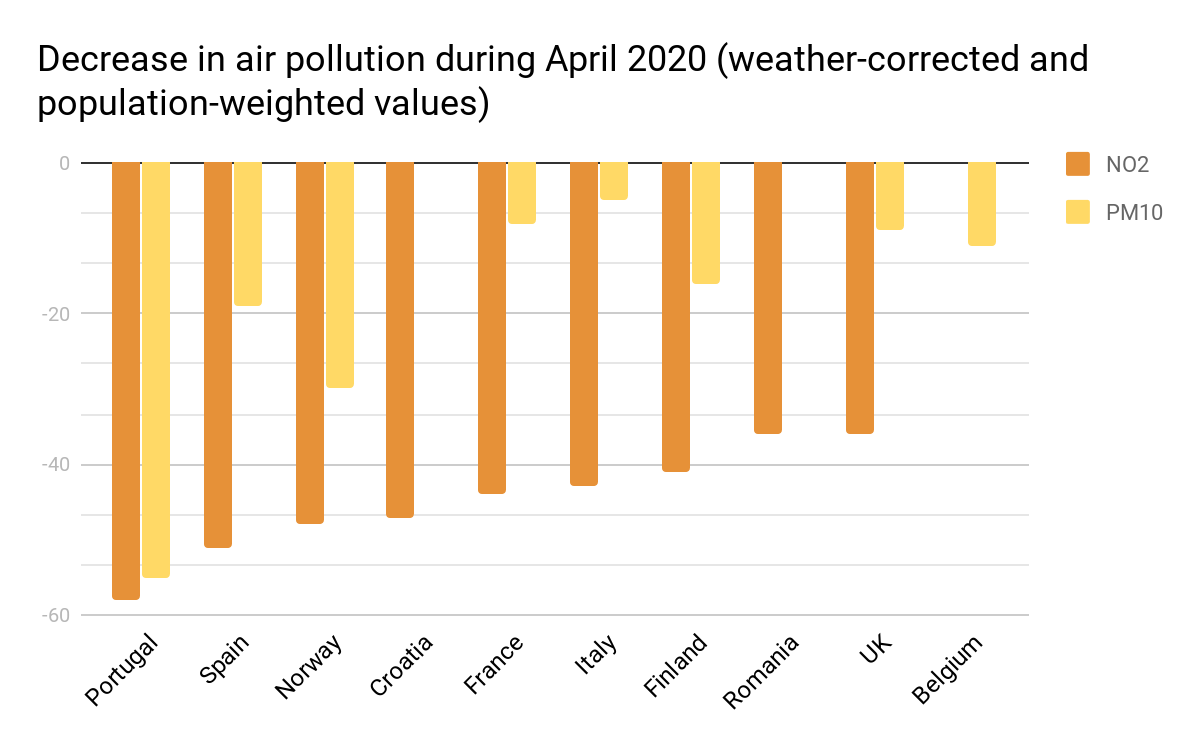
Data Source: https://energyandcleanair.org/air-pollution-deaths-avoided-in-europe-as-coal-oil-plummet/
So, if high levels of pollution are so bad for our health, what happens when air pollution decreases as it just has, even for a short time? As it turns out, a lot of illness is avoided and many lives are saved.
One study looked at the avoided deaths and positive health outcomes in Europe that came with this drop in air pollution. It found that the decreased air pollution resulted in avoiding a projected 11,000 early deaths in Europe, where nearly 500,000 deaths were attributable to air pollution in 2016
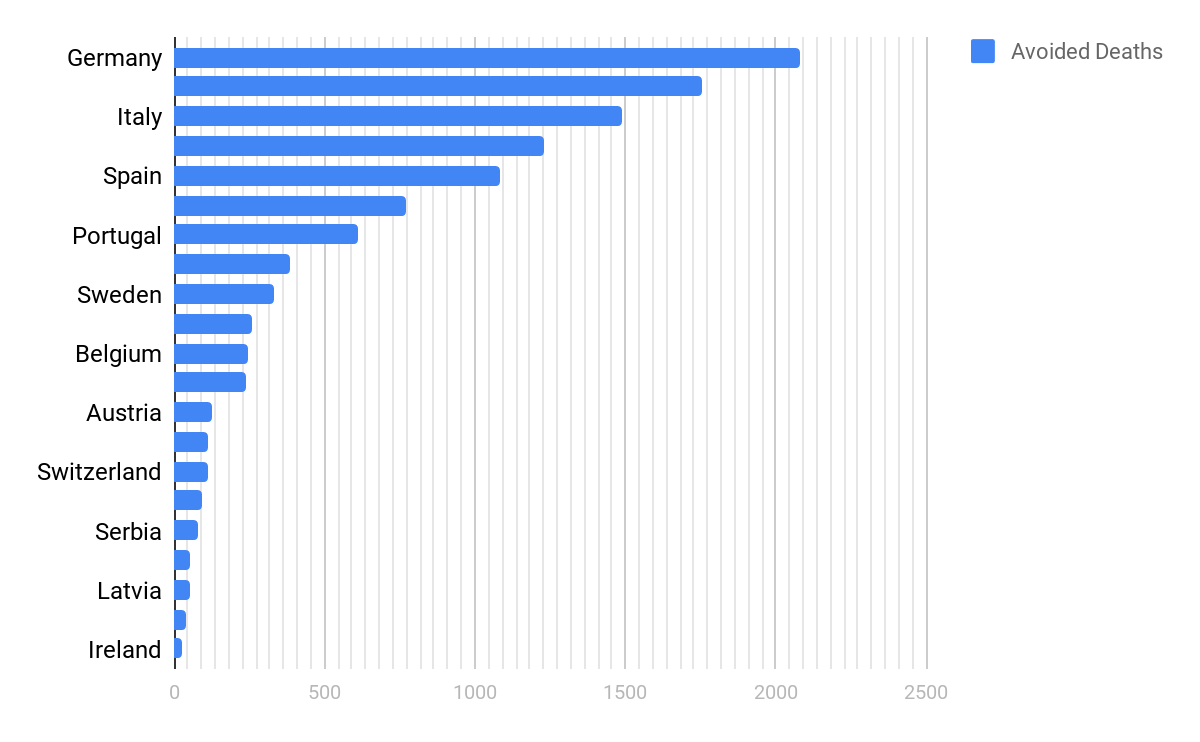
Data Source: https://energyandcleanair.org/air-pollution-deaths-avoided-in-europe-as-coal-oil-plummet/
It also found that several key negative health impacts were avoided, projecting 1.3 million fewer days of work missed due to illness, 6,000 fewer new cases of asthma in children and nearly 2,000 avoided trips to emergency rooms due to asthma attacks. Finally, the reduction in air pollution would mean 575 fewer preterm births.

Source: https://energyandcleanair.org/air-pollution-deaths-avoided-in-europe-as-coal-oil-plummet/
These findings are crucial for understanding how our health can be improved by a reduction in air pollution. If we act on this knowledge, asthma-related hospital visits may decrease; hundreds more pregnancies could be carried to full-term, avoiding many potential lifelong health problems; and children could live healthier lives.
This case study focuses on the experience of Europe with lower air pollution, and the projected positive health outcomes. However, based on its findings, we may hypothesize that similar health improvements would happen globally with lowered air pollution. Indeed, one study on China’s reduction in air pollution found that just two months of cleaner air saved the lives of up to 4,000 children and 73,000 adults. The WHO estimates that air pollution shortens our lives by a global average of 1 year and 8 months, and that “If global air quality met WHO’s Air Quality guideline for PM2.5 (10 µg/m3), people today would live an average of about 7 months longer.” The link is clear—cleaner air means longer, healthier lives for us all.
Mental Health Benefits
In addition to physical health benefits, the fall in emissions has led to a renewal in our connection with nature, boosting our mental health. On a visual level, people around the world have marveled at what clear skies look like, a memory that many had lost in recent decades. In India, people have been awed by the view of the Himalayas for the first time in their lives - a natural wonder usually lost behind clouds of smog. In personal conversations, my own family members have delighted in the blue skies over Beirut and in, once again, being able to see Lebanese mountain ranges that are normally shrouded in smog.

Himalayas, Nepal. Photo by Bisesh Gurung, unsplash.com.
Connecting with nature - whether in real life, online, or through art, by experiencing the weather, looking at a potted plant on your windowsill, a hike through the woods, and everything in between, increases mental wellbeing and one’s relationship to the world around us. These experiences are linked to many positive effects, including happiness, imagination, creativity, school performance, improved sleep and stress reduction. Reduced emissions have literally helped us see the world around us once again, reconnecting us with our natural surroundings and boosting our mental health.
Breathing Easier: Cleaner Air for a Stronger Future
The decrease in air pollution during the months of global lockdown has given us a unique glimpse of what a world with cleaner air could mean: increased life expectancy, improved quality of life, fewer early deaths, less burdened healthcare systems, and greater wellbeing. While the results of these studies are hopeful, they were borne out of a global disaster that brought grief and pain to many across the world. But, while we cannot draw happiness from the context in which these findings emerged, it is up to us to learn our lessons well and apply them to creating a healthier world. As we look ahead to our eventual pandemic-free future, we must ask ourselves: what steps can we take to deliberately pursue these health outcomes within the context of a thriving, better-functioning society?
Global Citizens’ Participation
It is incumbent upon us to do all we can to lower emissions. The drop in emissions we experienced during the first quarter of 2020 has been considerable, but it is not enough. To holistically care for our health as humans and that of the planet, we need an annual 7.6 percent drop in emissions, and they are only projected to fall 5% in 2020. Meeting our goals requires a creative, positive rethinking of our relationships on a global, national, and individual level, and of the roles we each play in contributing to harmful emissions.
We must redouble our demands for clean energy and lower carbon emissions. Since lockdowns have eased, around the world emissions have already begun rising again, in some cases exceeding pre-lockdown levels. In the context of the global response to the current pandemic, we have seen that willing governments are capable of acting quickly to face a threat head-on and implementing preventative measures to protect their populations. The capacity is there - it is the will that must be reinforced through sustained calls for action by the people.
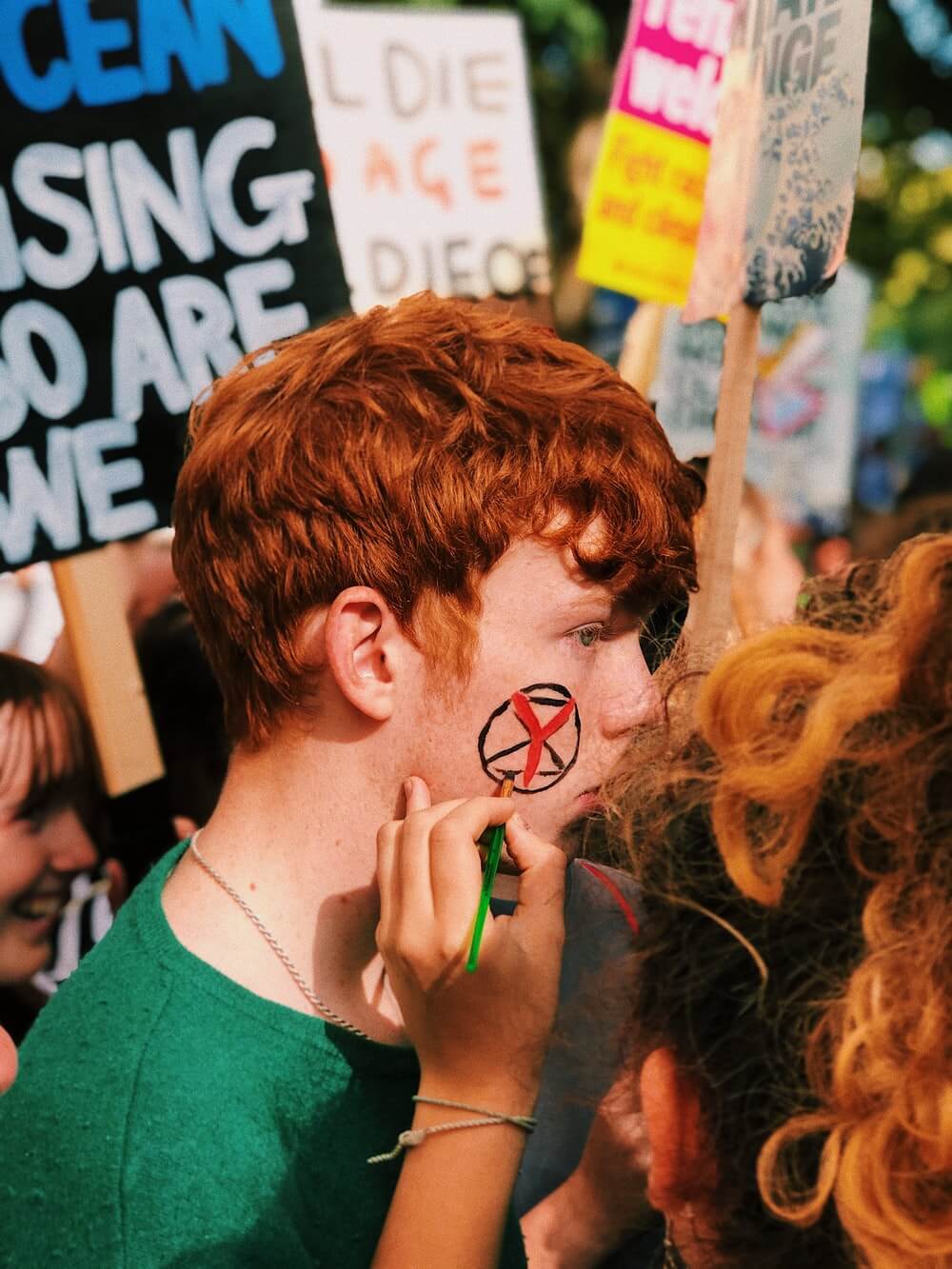
Global Climate Strike, London, UK. photo by Corie Kull, unsplash.com
One way to make sure governments prioritize people over profit is through the creation of citizens’ assemblies. A citizen’s assembly is a people-led, transparent, democratic body to pressure governments to follow through on the people’s demands for meaningful action to protect us from environmental breakdown. They have proven an effective means of communicating between the people and the government when the two are faced with a political standstill, and are gaining growing support.
Citizens’ assemblies’ potential effectiveness has led to their being adopted as XR’s third global demand. Emissions control is, moreover, already a key component of both France’s citizens’ assembly on climate and the UK’s recently convened citizens’ assembly. Governments are accountable to their people, and must be held to this.
Go Green, Go Clean
While maintaining the pressure on governments to protect our health and the environment, we can make changes to our own lifestyle and move towards a healthier way of life. Many of us have rediscovered the beauty of walking or biking as a way of getting around. From Kampala to Paris, a number of governments have recently encouraged this zero-emissions mode of transport with plans to create more pedestrian walkways and bike lanes. The more we use these services, the fewer emissions we create personally and the more we encourage governments to invest in this more sustainable kind of city planning.
With public concern over the environmental emergency growing rapidly, some governments have slowly introduced laws and regulations to control our environmental impact. Alarmingly, however, others have removed swaths of environmental regulations and rules in a bid to please big business.
Money clearly talks, and we can use ours to pressure organizations and businesses to divest from fossil fuels and other polluting industries. After effective petitioning, The Royal Shakespeare Company decided to end its sponsorship by BP and, similarly, The National Theatre has agreed to end its Shell membership this year in an effort to go carbon neutral. Successes build on each other, and with the threat of losing money, businesses may suddenly begin to listen and take action.
It is our right to demand cleaner air and better health outcomes for ourselves and future generations. Such a future is within our reach, and it is within our means to achieve it. Many are now rejecting what was previously considered acceptable and don’t want to return to ‘normal’.
We have seen what is possible and must hold governments, industries, and companies accountable for their roles in causing and enabling air pollution and the resulting harm to our health. We must also make changes to our own lifestyles. We can live healthier lives. We can live longer lives. We can take our loved ones to hospital less often. We can give our children clean air. This is all possible. This is the moment to make those changes - to demand those changes - to make clean air ‘the new normal’.
The findings on emissions’ effects on our health have emerged from a global tragedy - one we do not wish to ever experience again. Let’s take these hard-learned lessons and forge a healthier future for us all.